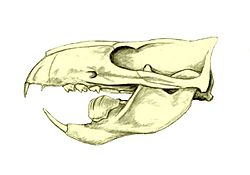Multituberculate facts for kids
Quick facts for kids Multituberculates |
|
|---|---|
 |
|
| Skull of Ptilodus | |
| Scientific classification | |
| Kingdom: | |
| Phylum: | |
| Class: | |
| Subclass: | |
| Order: |
†Multituberculata
Cope, 1884
|
| Suborders | |
|
|
The multituberculates were a very old group of mammals. They looked a bit like rodents, such as mice or beavers. These amazing creatures lived for about 166 million years! That's longer than any other group of mammals we know from fossils.
They eventually died out about 34 million years ago, during the late Eocene epoch. This happened because new mammals, like modern rodents, became better at finding food and living in different places.
Scientists have found fossils of at least 200 different kinds of multituberculates. Some were as small as a mouse, while others were as big as a beaver. They lived in many different ways. Some dug burrows underground, and others climbed trees like squirrels.
Multituberculates are a unique group. They are usually placed outside the two main groups of mammals alive today: placental mammals (like humans and dogs) and marsupials (like kangaroos), and monotremes (like platypuses). Some scientists think they might be a bit closer to placental and marsupials than to monotremes.
Contents
How Multituberculates Lived
Their Special Teeth
Multituberculates had a head shape similar to rodents. They had special cheek-teeth that were separated from their front teeth by a wide, empty space. This space is called a diastema.
Each cheek-tooth had several rows of small bumps, called cusps or tubercles. This is where their name comes from! These bumps on the upper teeth worked against similar bumps on the lower jaw teeth. This made an excellent chopping tool for their food.
What They Ate
Most small multituberculates probably ate seeds and nuts. They might also have eaten insects, worms, and fruit. Their chopping teeth were perfect for this kind of diet.
How They Had Babies
The bones in the hip area, called the pelvis, of multituberculates suggest something interesting. They likely gave birth to very tiny, helpless babies. This is similar to how modern marsupials, like kangaroos, have their young today.
Images for kids
See also
 In Spanish: Multituberculados para niños
In Spanish: Multituberculados para niños






